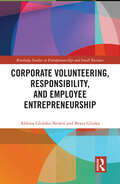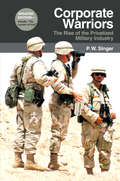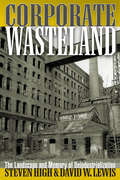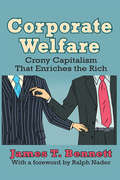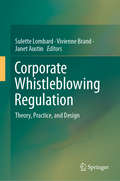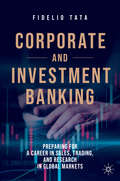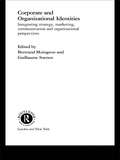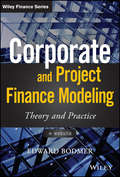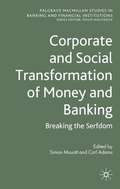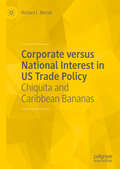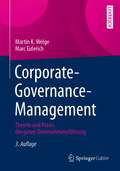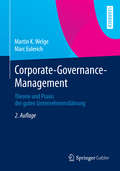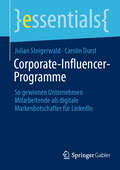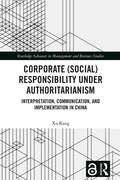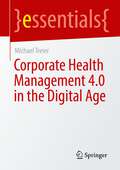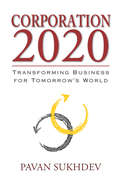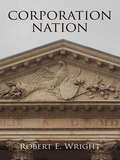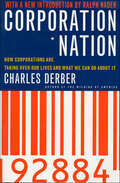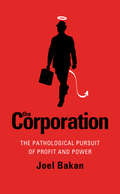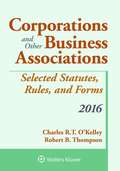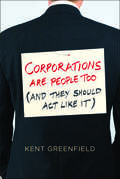- Table View
- List View
Corporate Volunteering, Responsibility and Employee Entrepreneurship (Routledge Studies in Entrepreneurship and Small Business)
by Beata Glinka Aldona Glińska-NeweśSupporting employee entrepreneurship is among major challenges contemporary organizations face. Many facets of corporate entrepreneurship are investigated, and the body of knowledge in the field is growing rapidly; nevertheless, there are still knowledge and research gaps to be filled. Notably, while there are studies linking HRM with corporate entrepreneurship, studies on connections between CSR-oriented practices and corporate/employee entrepreneurship are to be developed. The main goal of this book is to explain relationships between corporate volunteering and employee entrepreneurship in organisations. The book combines two extremely vivid fields of research: entrepreneurship and corporate social responsibility. Based on their own research, the authors present how participation in corporate volunteering, as one of the CSR practices in organisations, leads to strengthening employee entrepreneurial behaviour. The book offers a framework showing the role of CSR practices in shaping entrepreneurial and innovative employees’ behaviour. This book is aimed mainly at postgraduates, researchers and academics in the fields of entrepreneurship and corporate volunteering. As it touches vital fields of managerial education and management, it will also be of interest to master level students at universities or business schools as well as business practitioners.
Corporate Volunteering, Responsibility and Employee Entrepreneurship (Routledge Studies in Entrepreneurship and Small Business)
by Beata Glinka Aldona Glińska-NeweśSupporting employee entrepreneurship is among major challenges contemporary organizations face. Many facets of corporate entrepreneurship are investigated, and the body of knowledge in the field is growing rapidly; nevertheless, there are still knowledge and research gaps to be filled. Notably, while there are studies linking HRM with corporate entrepreneurship, studies on connections between CSR-oriented practices and corporate/employee entrepreneurship are to be developed.The main goal of this book is to explain relationships between corporate volunteering and employee entrepreneurship in organisations. The book combines two extremely vivid fields of research: entrepreneurship and corporate social responsibility. Based on their own research, the authors present how participation in corporate volunteering, as one of the CSR practices in organisations, leads to strengthening employee entrepreneurial behaviour. The book offers a framework showing the role of CSR practices in shaping entrepreneurial and innovative employees’ behaviour.This book is aimed mainly at postgraduates, researchers and academics in the fields of entrepreneurship and corporate volunteering. As it touches vital fields of managerial education and management, it will also be of interest to master level students at universities or business schools as well as business practitioners.
Corporate Warriors
by P. W. SingerSome have claimed that ?War is too important to be left to the generals,? but P. W. Singer asks ?What about the business executives? Breaking out of the guns-for-hire mold of traditional mercenaries, corporations now sell skills and services that until recently only state militaries possessed. Their products range from trained commando teams to strategic advice from generals. This new ?Privatized Military Industry? encompasses hundreds of companies, thousands of employees, and billions of dollars in revenue. Whether as proxies or suppliers, such firms have participated in wars in Africa, Asia, the Balkans, and Latin America. More recently, they have become a key element in U. S. military operations. Private corporations working for profit now sway the course of national and international conflict, but the consequences have been little explored. In this book, Singer provides the first account of the military services industry and its broader implications. Corporate Warriors includes a description of how the business works, as well as portraits of each of the basic types of companies: military providers that offer troops for tactical operations; military consultants that supply expert advice and training; and military support companies that sell logistics, intelligence, and engineering. The privatization of warfare allows startling new capabilities and efficiencies in the ways that war is carried out. At the same time, however, Singer finds that the entrance of the profit motive onto the battlefield raises a series of troubling questions'for democracy, for ethics, for management, for human rights, and for national security.
Corporate Wasteland: The Landscape and Memory of Deindustrialization
by David Lewis Steven HighDeindustrialization is not simply an economic process; it is also a social and cultural phenomenon. The rusting detritus of our industrial past-the wrecked halls of factories, abandoned machinery too large to remove, and now-useless infrastructures-has for decades been a part of the North American landscape. Through a unique blend of oral history, photographs, and interpretive essays, Corporate Wasteland investigates this fascinating terrain and the phenomenon of its loss and rediscovery.
Corporate Water Strategies
by William SarniIn the past businesses have viewed water as a minimal operational cost and not a strategic issue. However, water has now emerged as a critical issue for both corporations and the public sector in response to increased water demand, climatic risks and potentially negative impacts on brand value. This innovative book provides up to date information on global water issues and describes how companies can not only address these challenges but also implement high value global water strategies. It shows: Why water is a critical business issue for companies which now face water risk to their operations and brands; How new concepts such as embedded water and virtual water are forcing companies to think differently about how they use water to manufacture products; That companies need to develop a corporate water strategy to manage it as a key business issue and capture the real value of water; How companies can develop partnerships with non-governmental organizations to implement water strategies
Corporate Welfare: Crony Capitalism That Enriches the Rich
by James T. BennettFrom the time of Alexander Hamilton's "Report on Manufactures" through the Great Depression, American towns and cities sought to lure footloose companies by offering lavish benefits. These ranged from taxpayer-financed factories, to tax exemptions, to outright gifts of money. This kind of government aid, known as "corporate welfare," is still around today. After establishing its historical foundations, James T. Bennett reveals four modern manifestations.His first case is the epochal debate over government subsidy of a supersonic transport aircraft. The second case has its origins in Southern factory relocation programs of the 1930s�the practice of state and local governments granting companies taxpayer financed incentives. The third is the taking of private property for the enrichment of business interests. The fourth�export subsidies�has its genesis in the New Deal but matured with the growth of the Export-Import Bank, which subsidizes international business exchanges of America's largest corporate entities.Bennett examines the prospects for a successful anti-corporate welfare coalition of libertarians, free market conservatives, Greens, and populists. The potential for a coalition is out there, he argues. Whether a canny politician can assemble and maintain it long enough to mount a taxpayer counterattack upon corporate welfare is an intriguing question.
Corporate Whistleblowing Regulation: Theory, Practice, and Design
by Sulette Lombard Vivienne Brand Janet AustinThis book adopts a cross-jurisdictional perspective to consider contemporary corporate whistleblowing issues from an ethical theoretical perspective, regulatory perspective, and practical perspective. It includes in particular arguments in favour of and against the adoption of financial incentive schemes for whistleblowers, as well as the potential implications of adopting such schemes. This approach provides a valuable opportunity for comparison from a law reform perspective. The book brings together authors from various jurisdictions – Canada, Australia, and the USA – who, through their exposure to this area of law, be it as practitioners, regulators, or academics, offer valuable and interesting insights on the emerging and topical area of corporate whistleblowing generally, and whistleblowing rewards in particular. These three jurisdictions were selected on the basis of their reform-oriented stance on corporate whistleblowing and/or implementation of financial incentives for whistleblowing, creating an opportunity to assess contemporary regulatory structures and in particular how incentives measures could interact with corporate whistleblowing regulatory frameworks, and how they could contribute to improved governance. The reasons for the rejection of the notion of financial incentives in the United Kingdom are also reviewed, in order to provide a comparative overview. The book provides useful guidance for those who may be affected by the implementation of corporate whistleblowing schemes, including for reward, whether as regulators, practitioners, company directors, or whistle blowers.
Corporate and Investment Banking: Preparing for a Career in Sales, Trading, and Research in Global Markets
by Fidelio TataThis book provides unique information to prepare graduates and newly hired corporate and investment banking professionals for a career in the global markets environment of large universal and international investment banks. It shows the interrelationship between the three specific business functions of sales, trading, and research, as well as the interaction with corporate and institutional clients. The book fills a gap in the available literature by linking financial market theory to the practical aspects of day-to-day operations on a trading floor and offers a taxonomy of the current banking business, providing an in-depth analysis of the main market participants in the global markets ecosystem. Engaging the reader with case studies, anecdotes, and industry color, the book addresses the risks and opportunities of the global markets business in today’s global financial markets both from a theoretical and from a practitioner’s perspective and focuses on the most important fixed-income financial instruments from a pricing, risk-management, and client-marketing perspective.
Corporate and Organizational Identities: Integrating Strategy, Marketing, Communication and Organizational Perspective
by Bertrand Moingeon Guillaume SoenenThis edited book is devoted to an issue of increasing importance in management theory and practice-organizational identity. The concept of organizational identity has received attention in many disciplines such as strategic management, marketing, communication and public relations and organization theory. In practice a number of consultancy firms h
Corporate and Project Finance Modeling: Theory And Practice (Wiley Finance Ser.)
by Edward BodmerA clear and comprehensive guide to financial modeling and valuation with extensive case studies and practice exercisesCorporate and Project Finance Modeling takes a clear, coherent approach to a complex and technical topic. Written by a globally-recognized financial and economic consultant, this book provides a thorough explanation of financial modeling and analysis while describing the practical application of newly-developed techniques. Theoretical discussion, case studies and step-by-step guides allow readers to master many difficult modeling problems and also explain how to build highly structured models from the ground up. The companion website includes downloadable examples, templates, and hundreds of exercises that allow readers to immediately apply the complex ideas discussed.Financial valuation is an in-depth process, involving both objective and subjective parameters. Precise modeling is critical, and thorough, accurate analysis is what bridges the gap from model to value. This book allows readers to gain a true mastery of the principles underlying financial modeling and valuation by helping them to:Develop flexible and accurate valuation analysis incorporating cash flow waterfalls, depreciation and retirements, updates for new historic periods, and dynamic presentation of scenario and sensitivity analysis;Build customized spreadsheet functions that solve circular logic arising in project and corporate valuation without cumbersome copy and paste macros;Derive accurate measures of normalized cash flow and implied valuation multiples that account for asset life, changing growth, taxes, varying returns and cost of capital;Incorporate stochastic analysis with alternative time series equations and Monte Carlo simulation without add-ins;Understand valuation effects of debt sizing, sculpting, project funding, re-financing, holding periods and credit enhancements.Corporate and Project Finance Modeling provides comprehensive guidance and extensive explanation, making it essential reading for anyone in the field.
Corporate and Social Transformation of Money and Banking
by Simon Mouatt Carl AdamsAs the real economy is increasingly digitalized, banking lags behind. It is thus not well placed to support the new economy. The book provides some perspective on the changes taking place, identifying the systemic weaknesses in the traditional financial infrastructure, and proposing some radical rethinking to address systemic financial instability.
Corporate tax law
by Peter HarrisMany corporate tax systems lack structure. Focusing on structural defects and how they are addressed in practice, this comprehensive and comparative analysis of corporate tax systems uses a conceptual framework to illustrate and analyse the many difficult issues corporations pose. This framework is enhanced by the examination of a large body of legal rules and practical considerations which demonstrate how corporate tax systems work in practice. While adopting a broad comparative approach, the analysis also drills down into the detail of influential corporate tax systems in order to illustrate the major issues they face and the options available to them.
Corporate versus National Interest in US Trade Policy: Chiquita and Caribbean Bananas
by Richard L. BernalThis book provides a history of the WTO US-EU banana dispute through the lens of a major actor: the US-owned multinational firm, Chiquita Brands International. It documents and explains how Chiquita succeeded in having the Clinton administration pursue a trade policy of forcing the European Union to dismantle its preferential banana import regime for exports from the small English-speaking Caribbean (ESC) countries. The export of bananas was critically important to the social stability and economic viability of these countries and that was in the national security interest of the United States. The experience indicates that succeeding in this goal was detrimental to U.S. national security interest in the Caribbean.
Corporate-Governance-Management: Theorie und Praxis der guten Unternehmensführung
by Martin K. Welge Marc EulerichDas Lehrbuch erläutert umfassend alle betriebswirtschaftlichen Perspektiven und Fragestellungen guter Corporate Governance aus theoretischer und praktischer Sicht. Es beschreibt die Aufgaben der Akteure und gibt Handlungsempfehlungen zur operativen sowie strategischen Unternehmensführung und -überwachung durch Vorstand bzw. Aufsichtsrat. Der Fokus liegt dabei auf den Strukturen, Organen und Akteuren der Corporate Governance, den strategischen und operativen Kernprozessen in den Unternehmen, insbesondere innerhalb des Vorstandes und Aufsichtsrats, sowie möglichen Steuerungsinstrumentarien.Für die dritte Auflage wurde das Buch umfassend aktualisiert und überarbeitet, insbesondere durch die Vorgaben des neustrukturierten Deutschen Corporate Governance Kodex.
Corporate-Governance-Management: Theorie und Praxis der guten Unternehmensführung
by Martin K. Welge Marc EulerichDas Lehrbuch erläutert umfassend alle betriebswirtschaftlichen Perspektiven und Fragestellungen guter Corporate Governance aus theoretischer und praktischer Sicht. Es beschreibt die Aufgaben der Akteure und gibt Handlungsempfehlungen zur operativen sowie strategischen Unternehmensführung und -überwachung durch Vorstand bzw. Aufsichtsrat. Der Fokus liegt dabei auf den Strukturen, Organen und Akteuren der Corporate Governance, den strategischen und operativen Kernprozessen in den Unternehmen, insbesondere innerhalb des Vorstandes und Aufsichtsrats, sowie möglichen Steuerungsinstrumentarien.Die zweite, grundlegend überarbeitete Auflage bindet zahlreiche neue Inhalte ein. Neben einem umfassenden Kapitel zu zwischenmenschlichen Interaktionen in Vorstand und Aufsichtsrat (sog. „Board Dynamics“) werden mehrere internationale Corporate-Governance-Systeme verglichen sowie die Bereiche Family Governance und Public Governance beschrieben. Ausführliche Fall- und Praxisbeispiele verdeutlichen dem Leser die große praktische Relevanz des Themas.
Corporate-Influencer-Programme: So gewinnen Unternehmen Mitarbeitende als digitale Markenbotschafter für LinkedIn (essentials)
by Carolin Durst Julian SteigerwaldDieses essential bietet eine fundierte Analyse und praktische Hinweise zur erfolgreichen Implementierung von Corporate-Influencer-Programmen auf LinkedIn. Es beleuchtet die entscheidenden Einflussfaktoren, die Mitarbeitende motivieren, als digitale Markenbotschafter für ihr Unternehmen zu agieren und zeigt auf, wie Unternehmen diese Potenziale optimal nutzen können. In einer detaillierten Conjoint-Analyse werden die Rahmenbedingungen für erfolgreiche Programme untersucht – von besonderer Bedeutung ist dabei eine moderne und gelebte Unternehmenskultur. Für alle Verantwortlichen in der Unternehmenskommunikation, HR und Marketing, die ihre Strategien im Bereich Corporate Influencing optimieren und langfristig eine positive Arbeitgebermarke aufbauen wollen.
Corporate-Startup-Partnerschaften: Innovation durch Kollaboration (Organisationskompetenz Zukunftsfähigkeit)
by Jasmin Weber Alexander ElzEtablierte Unternehmen sehen sich zunehmend mit Entwicklungen konfrontiert, die die Anforderungen an ihre Transformationsgeschwindigkeit erhöhen – so wird das Rennen um die vorderen Plätze beispielsweise durch die Digitalisierung angefacht. Dabei stellen sie immer häufiger fest, dass ihnen der eigene, teils jahrzehntelange Erfolg durchaus im Weg stehen kann und die benötigte Innovationskraft oft nicht innerhalb, sondern außerhalb des Unternehmens zu finden ist. Eine Möglichkeit, diesen Herausforderungen zu begegnen, ist die Kollaboration mit Startups.Corporate-Startup-Partnerschaften vereinen die Kapazitäten etablierter Unternehmen mit der Flexibilität von Startups, was zu mehr Innovationsfähigkeit und damit Wettbewerbsvorteilen führen kann. In diesem Buch werden die Vor- und Nachteile solcher Partnerschaften, die Hebel für ihren Erfolg und die Phasen ihrer Evolution durch erfahrene Expert:innen beschrieben. Praktische Handlungsempfehlungen ergänzen die detaillierte Analyse.
Corporate: Interpretation, Communication, and Implementation in China (Routledge Advances in Management and Business Studies)
by Xu KangThis book provides an in-depth exploration of corporate social responsibility (CSR) in the authoritarian context. It challenges prevailing CSR frameworks, which largely derive from liberal democratic contexts and overlook how political institutions shape the conceptualisation and practice of corporate responsibility. By situating CSR within China’s political-economic system, the book sheds light on how CSR is dynamically interpreted, strategically communicated, and selectively implemented by corporate and state actors.Drawing on a mixed-method research design, the study analyses both qualitative and quantitative evidence. The analysis integrates policy documents, regulatory frameworks, CSR and sustainability reports from Chinese corporations, and in-depth qualitative interviews with corporate managers, NGO leaders, and experts. The findings highlight how CSR in China emerges through the normative interplay between market logics and power politics, involving various actors, including enterprises, state entities, and NGOs. The book also presents a critical account of how Chinese companies strategically adapt CSR discourses to align with governmental priorities while navigating complex stakeholder relationships.A book of vital interest to researchers in business ethics, international business and Asian studies, it will also appeal to practitioners and policymakers seeking to enhance strategies and policies for responsible business conduct.
CorporateHealthManagement4.0inthedigitalage (essentials)
by Michael TreierThe essentials discusses the possibilities of digital occupational health management (D-BGM), from health communication such as health portals to wearables and health apps to online coaching, with regard to the requirements of Work 4.0. The reader receives information on the integration of digital components in the health management portfolio and an argumentation sketch with regard to the benefits of digitalization for increasing the effectiveness of health management measures in a modern working world. Corresponding success factors are elaborated and the potentials and risks of D-BGM are identified.
Corporation 2020: Transforming Business for Tomorrow's World
by Pavan SukhdevThere is an emerging consensus that all is not well with today's market-centric economic model. Although it has delivered wealth over the last half century and pulled millions out of poverty, it is recession-prone, leaves too many unemployed, creates ecological scarcities and environmental risks, and widens the gap between the rich and the poor. Around $1 trillion a year in perverse subsidies and barriers to entry for alternative products maintain "business-as-usual" while obscuring their associated environmental and societal costs. The result is the broken system of social inequity, environmental degradation, and political manipulation that marks today's corporations. We aren't stuck with this dysfunctional corporate model, but business needs a new DNA if it is to enact the comprehensive approach we need. Pavan Sukhdev lays out a sweeping new vision for tomorrow's corporation: one that will increase human wellbeing and social equity, decrease environmental risks and ecological losses, and still generate profit. Through a combination of internal changes in corporate governance and external regulations and policies, Corporation 2020 can become a reality in the next decade--and it must, argues Sukhdev, if we are to avert catastrophic social imbalance and ecological harm. Corporation 2020 presents new approaches to measuring the true costs of business and the corporation's obligation to society. From his insightful look into the history of the corporation to his thoughtful discussion of the steps needed to craft a better corporate model, Sukhdev offers a hopeful vision for the role of business in shaping a more equitable, sustainable future.
Corporation Nation
by Robert E. WrightFrom bank bailouts and corporate scandals to the financial panic of 2008 and its lingering effects, corporate governance in America has been wracked with crises. Amid a weakening system of checks and balances in which corporate executives have little incentive to protect shareholder interests, U.S. corporations are growing larger and more irresponsible at the same time. But dependence on corporate profit was crucial to the early republic's growth, success, and security: despite protests that incorporated business was an inefficient and potentially corrupting system, U.S. state governments chartered more corporations per capita than any other nation--including Britain--effectively making the United States a "corporation nation." Drawing on legal and economic history, Robert E. Wright traces the development and decline of corporate institutions in America, connecting today's financial failures to deteriorating corporate law.In the nineteenth century, checks and balances kept managerial interests aligned with those of stockholders, and public opinion grew supportive as corporations raised billions of dollars to finance infrastructure such as transportation networks, financial systems, and manufacturing operations. But many of these checks and balances were dismantled after the Civil War, allowing leeway for the managerial malfeasance that spiraled into economic crisis in the twenty-first century. Bolstered with archival and original data, including the first complete count of American business corporations before the Civil War, Corporation Nation makes a compelling argument for improved internal governance and more effective external government regulation.
Corporation Nation: How Corporations Are Taking Over Our Lives and What We Can Do About It
by Charles DerberForeword by Ralph Nader. In Corporation Nation Derber addresses the unchecked power of today's corporations to shape the way we work, earn, buy, sell, and think—the very way we live. Huge, far-reaching mergers are now commonplace, downsizing is rampant, and our lines of communication, news and entertainment media, jobs, and savings are increasingly controlled by a handful of global—and unaccountable—conglomerates. We are, in effect, losing our financial and emotional security, depending more than ever on the whim of these corporations. But it doesn't have to be this way, as this book makes clear. Just as the original Populist movement of the nineteenth century helped dethrone the robber barons, Derber contends that a new, positive populism can help the U.S. workforce regain its self-control. Drawing on core sociological concepts and demonstrating the power of the sociological imagination, he calls for revisions in our corporate system, changes designed to keep corporations healthy while also making them answerable to the people. From rewriting corporate charters to altering consumer habits, Derber offers new aims for businesses and empowering strategies by which we all can make a difference.
Corporation: The Pathological Pursuit of Profit and Power (Collection Revue Commerce)
by Joel BakanAs incisive as Eric Schlosser's bestselling Fast Food Nation, as rigorous as Joseph E. Stiglitz's Globalization and Its Discontents, and as scathing as Michael Moore's Stupid White Men, Joel Bakan's new book is a brilliantly argued account of the corporation's pathological pursuit of profit and power. An eminent law professor and legal theorist, Bakan contends that the corporation is created by law to function much like a psychopathic personality whose destructive behavior, if left unchecked, leads to scandal and ruin.In the most revolutionary assessment of the corporation as a legal and economic institution since Peter Drucker's early works, Bakan backs his premise with the following claims: • The corporation's legally defined mandate is to pursue relentlessly and without exception its own economic self-interest, regardless of the harmful consequences it might cause to others—a concept endorsed by no less a luminary than the Nobel Prize-winning economist Milton Friedman. • The corporation's unbridled self-interest victimizes individuals, society, and, when it goes awry, even shareholders and can cause corporations to self-destruct, as recent Wall Street scandals reveal. • While corporate social responsibility in some instances does much good, it is often merely a token gesture, serving to mask the corporation's true character. • Governments have abdicated much of their control over the corporation, despite its flawed character, by freeing it from legal constraints through deregulation and by granting it ever greater authority over society through privatization.Despite the structural failings found in the corporation, Bakan believes change is possible and outlines a far-reaching program of concrete, pragmatic, and realistic reforms through legal regulation and democratic control.Backed by extensive research, The Corporation draws on in-depth interviews with such wide-ranging figures as CEO Hank McKinnell of Pfizer, Nobel Prize-winner Milton Friedman, business guru Peter Drucker, and critic Noam Chomsky of MIT.
Corporations And Other Business Associations: Selected Statutes, Rules, And Forms (2016 Edition)
by Charles R. T. O'Kelley Robert B. ThompsonCorporations and Other Business Associations Selected Statutes, Rules, and Forms: 2016 Supplement
Corporations Are People Too: (And They Should Act Like It)
by Kent GreenfieldWhy we’re better off treating corporations as people under the law—and making them behave like citizens Are corporations people? The U.S. Supreme Court launched a heated debate when it ruled in Citizens United that corporations can claim the same free speech rights as humans. Should corporations be able to claim rights of free speech, religious conscience, and due process? Kent Greenfield provides an answer: Sometimes. With an analysis sure to challenge the assumptions of both progressives and conservatives, Greenfield explores corporations' claims to constitutional rights and the foundational conflicts about their obligations in society. He argues that a blanket opposition to corporate personhood is misguided, since it is consistent with both the purpose of corporations and the Constitution itself that corporations can claim rights at least some of the time. The problem with Citizens United is not that corporations have a right to speak, but for whom they speak. The solution is not to end corporate personhood but to require corporations to act more like citizens.
